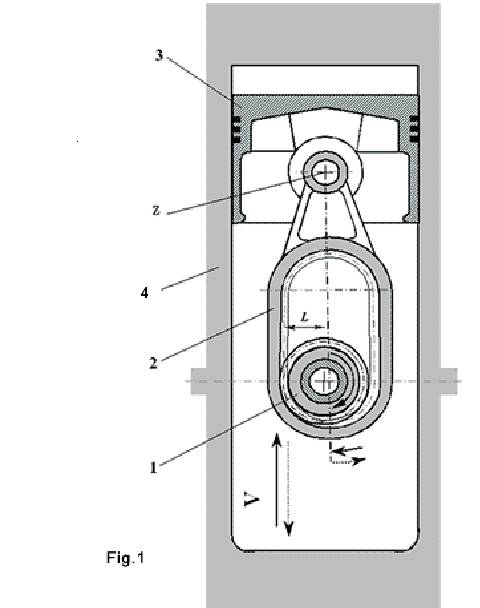





Published on Apr 02, 2024
Running gearing is a new type of mechanism designed to transform progressive motion into rotary motion. The term "running gearing" is only a temporary name given to the mechanism and the mechanism has not yet been given its definite name.
The running gearing is developed by Mr. V.A.Vorgushin, an engineer, a M.T.S. in co-authorship with Mr. P.A. Shishkin, an engineer.
The technology of a running gearing makes it possible to withdraw from an engine its main component - a crank mechanism and to improve the engine's parameters.
The technology of the running gear can be applied to all formerly manufactured engines, equipped with crank mechanisms. Both modernization of the available stock of engines and realization of new projects may become a very profitable business for a number of years.
The arrangement of the engine is shown in figure-1. The running gearing is made up of toothed gear 1 seated on the engine shaft and being in constant mesh with gear frame 2. Gear frame 2 is shaped consisting of two racks of equal length and two toothed semicircles of equal radii. By this alternative the gear frame is connected to piston 3 of cylinder block 5 via a motion unit of Z axis.
For fixing of the extreme left and the extreme right positions of gear frame 2 (fixing of L dimension as per fig.) the device is equipped with a mechanism of dynamic fixing (not shown in fig.1).

A mechanism of dynamic fixing is the cam-type. It comprises a cam itself and two linear rests. The working face of the cam represents an arc of the sector of a circle. The cam and toothed gear 1 are seated on the axis of rotation of the shaft and they are stationary relative to each other. Linear rests are fixed along the gear racks; working faces of linear rests are the surfaces facing the axis of symmetry of the gear frame.
The comparison of the running gearing engine with conventional crank engine can be done under four categories. They are
1. Kinematics.
2. Gas dynamics.
3. Dimension and mass.
4. Production cost
An intensive rise in the piston velocity up to the maximum value at the initial stroke creates good conditions for using the air flow inertia and for developing of a dynamic charging effect of the cylinder due to the higher discharging in front of the piston bottom moving away fastly. Since the flow rate in an inlet pipeline is proportional to the piston velocity - the degree of charging will increase with the rise of revolutions, ensuring a considerable increase in the power. On the other hand this property must improve the engine throttle characteristics by reducing the required range of turning of a throttle gate.
The extent of engine throttling will decrease. The factor of dynamic charging and the factor of reduction in the degree of throttling will increase the efficiency of the unit in all modes. Gain in power in this case does not require the availability of options (a turbine and a compressor).
When estimating the velocity variations before and after the upper dead centre (Fig.2), it can be noted, that the piston velocity in an running gearing engine changes much more intensively, than in a typical engine with a crank mechanism. This condition should have a beneficial effect on antiknocking resistance of the operation process. Actually a rise in velocities near UDC means an adequate reduction of duration of the piston stay in the zone of the compression ratio limiting values and this in its turn reduces the probability of knocking and smoothes off the consequences of its manifestation.
It is observed that with the decrease in a scale factor, i.е. with the reduction of time intervals of the cycle, a tendency to knocking is fastly diminishing and starting from a certain value of similarity parameters it absolutely vanishes, even for very high degrees of compression. All the foregoing arguments considered we anticipate high anti-knock properties of running gearing engines, which will allow them to burn safely the lowest octane gasoline brands.
Based on the kinematic properties of a running gearing which are manifested in redistribution of velocities over the piston stroke, a conclusion can be made that losses for the cooling system are reduced. It has been known that in other equal conditions, the amount of heat passing through the unit of the wall area is proportional to the time of the gases contact.
Graphs of piston velocities (fig.2) clearly show that in the region of the highest temperatures of the cycle (the 1-st quarter of the expansion stroke) piston velocities of running gearing engines considerably exceed those of crank mechanism engines. Consequently, the contact time of gases for each elementary segment of the travel is considerably lower. It is evident from the calculations that losses for the cooling system are reduced by 1,5-1,6 times.
It is important to make a remark about a gas distribution system. If for four-stroke running gearing engines the gas distribution systems differ not at all from the standard type, but, regretfully, for two-stroke engines the use of a running gearing scheme brings about a need for increasing by 40-50% the stroke portion, being assigned for outlet and inlet ports. In this case it is caused by the negative effect of the high piston velocity near LDC on the time-section of gas distribution ports.
A need for a big portion of waste stroke for the gas distribution ports impedes the selection of optimum parameters of a running gearing as S/D cylinder ratio is increased.
The mentioned disadvantages make a four-stroke cycle be more advantageous for a running gearing engine
| Are you interested in this topic.Then mail to us immediately to get the full report.
email :- contactv2@gmail.com |